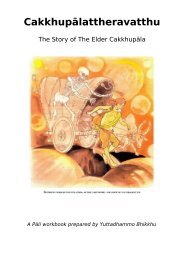Lessons In Practical Buddhism - Sirimangalo.Org
Lessons In Practical Buddhism - Sirimangalo.Org
Lessons In Practical Buddhism - Sirimangalo.Org
Create successful ePaper yourself
Turn your PDF publications into a flip-book with our unique Google optimized e-Paper software.
“Rising” and “falling” are concise explanations of what’s<br />
occurring at each moment. It doesn’t really matter what<br />
word you use, as long as it is an as-concise-as-possible<br />
understanding of what’s happening. When you feel pain in<br />
the body, you just focus on the pain and remind yourself that<br />
it’s pain. Normally pain is an object of aversion that we’d<br />
rather not focus on and would much rather escape from.<br />
When we say to ourselves again and again, “pain, pain,<br />
pain,” we change that. We change from reacting, our<br />
reactionary behaviour, to simply interacting – accepting,<br />
understanding, and being able to live with the reality in front<br />
of us. When we think of something, we remind ourselves,<br />
“thinking”, just knowing that we’re thinking.<br />
It might seem a pointless exercise on the surface, but think<br />
about how often our thoughts destroy us; thoughts about<br />
what we’ve done in the past, bad things we’ve done or bad<br />
things others have done to us, worries about the future, fear<br />
of what may come, and so on. We are quite capable of<br />
destroying ourselves with our minds, creating great amounts<br />
of suffering for ourselves and others due simply to thoughts<br />
of past and future. When you say to yourself “thinking,<br />
thinking”, you see that it is just a thought, and that it<br />
disappears in an instant with no remainder. It doesn’t really<br />
hang over you like a curse or doom that you must carry<br />
around forever. It’s just a thought.<br />
The Buddha’s teaching is sandiṭṭhiko – you see it for yourself,<br />
and can verify the truth of reality for yourself. One of the<br />
great reasons for wanting to teach mindfulness meditation to<br />
other people is because it is so simple and easy to practice,<br />
perfectly free from dogma or belief of any sort. When you<br />
see people suffering from things that could be completely<br />
cured with a simple explanation of how to be mindful, it feels<br />
too good to keep to yourself. The truth is that most of the<br />
problems in the world could be solved with just a few<br />
minutes of explanation on how to listen to and learn from<br />
oneself, if only people would care to try.<br />
These days, many people contact me with what seem to be<br />
life-threatening problems of anxiety, depression, addiction,<br />
and so on. Often just one e-mail explaining these basic<br />
concepts in a way that relates to the problem they are<br />
75












